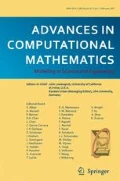Abstract
We derive and analyse four algorithms for computing the current induced on a thin straight wire by a transient electric field. They all involve solving the thin wire electric field integral equations (EFIEs) and consist of a very accurate differential equations solver together with various schemes to approximate the vector potential integral equation. We carry out a rigorous numerical stability analysis of each of these methods. This has not previously been done for solution schemes for the thin wire EFIEs. Each scheme is shown to be stable and convergent provided the radius of the wire is small enough for the thin wire equations to be a valid model.
Similar content being viewed by others
References
A.R. Bretones, R.G. Martin and A. Salinas, Dotig1, a time-domain numerical code for the study of the interaction of electromagnetic pulses with thin-wire structures, COMPEL 8(1989)39–61.
R. Courant and D. HilbertMethods of Mathematical Physics, Vol. 2:Partial Differential Equations (Wiley, 1962).
P.J. Davies, Numerical stability and convergence of approximations of retarded potential integral equations, SIAM J. Numer. Anal., to appear.
P.J. Davies, Stability of time-marching numerical schemes for the electric field integral equation, J. Electromag. Waves Appl. 8(1994)85–114.
D. S. Jones,Theory of Electromagnetism (Oxford University Press, 1964).
D.S. Jones,Acoustic and Electromagnetic Waves (Oxford University Press, 1986).
R.G. Martin, A. Salinas and A.R. Bretones, Time-domain integral equation methods for transient analysis, IEEE A&P 34(1992)15–22.
J.H. Mathews,Numerical Methods for Mathematics, Science and Engineering, 2nd ed. (Prentice-Hall, 1992).
E.K. Miller, A.J. Poggio and G.J. Burke, An integro-differential equation technique for the time-domain analysis of thin wire structures. I. The numerical method, J. Comp. Phys. 12(1973)24–48.
E.K. Miller, A.J. Poggio and G.J. Burke, An integro-differential equation technique for the timedomain analysis of thin wire structures. II. Numerical results, J. Comp. Phys. 12(1973)210–233.
E.K. Miller and J.A. Landt, Direct time-domain techniques for transient radiation and scattering from wires, Proc. IEEE 68(1980)1396–1423.
A.R. Mitchell and D.F. Griffiths,The Finite Difference Method in Partial Differential Equations (Wiley, 1980).
R.D. Richtmyer and K.W. Morton,Difference Methods for Initial Value Problems (Interscience, 1967).
B.P. Rynne, Stability and convergence of time marching methods in scattering problems, IMA J. Appl. Math. 35(1985)297–310.
B.P. Rynne and P.D. Smith, Stability of time marching algorithms for the electric field equations, J. Electromag. Waves Appl. 4(1990)1181–1205.
A. Salinas, A.R. Bretones, R.G. Martin and J. Fornieles, An improvement of the dotig1 code,IEE Int. Conf. on Comp. Electromag. (1991) pp. 222–225.
A.G. Tijhuis, Toward a stable marching on in time method for two dimensional transient electromagnetic scattering problems, Radio Science 19(1984)1311–1317.
Author information
Authors and Affiliations
Rights and permissions
About this article
Cite this article
Davies, P.J., Duncan, D.B. Time-marching numerical schemes for the electric field integral equation on a straight thin wire. Adv Comput Math 2, 279–317 (1994). https://doi.org/10.1007/BF02521113
Received:
Revised:
Issue Date:
DOI: https://doi.org/10.1007/BF02521113




